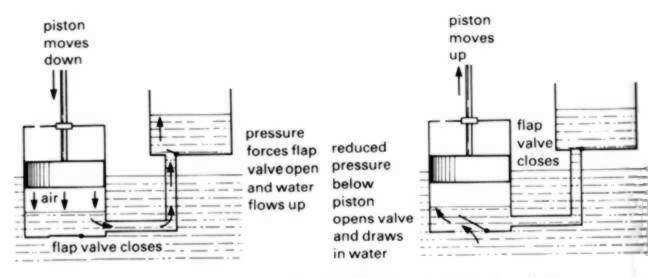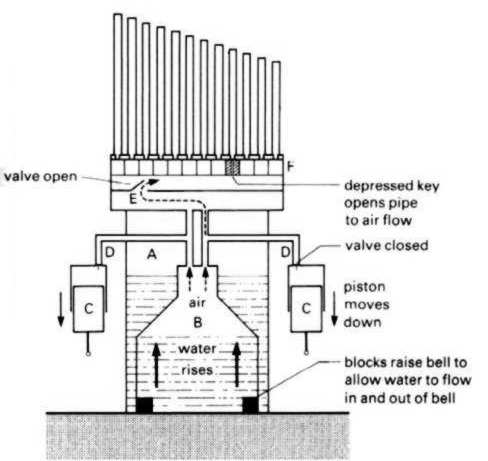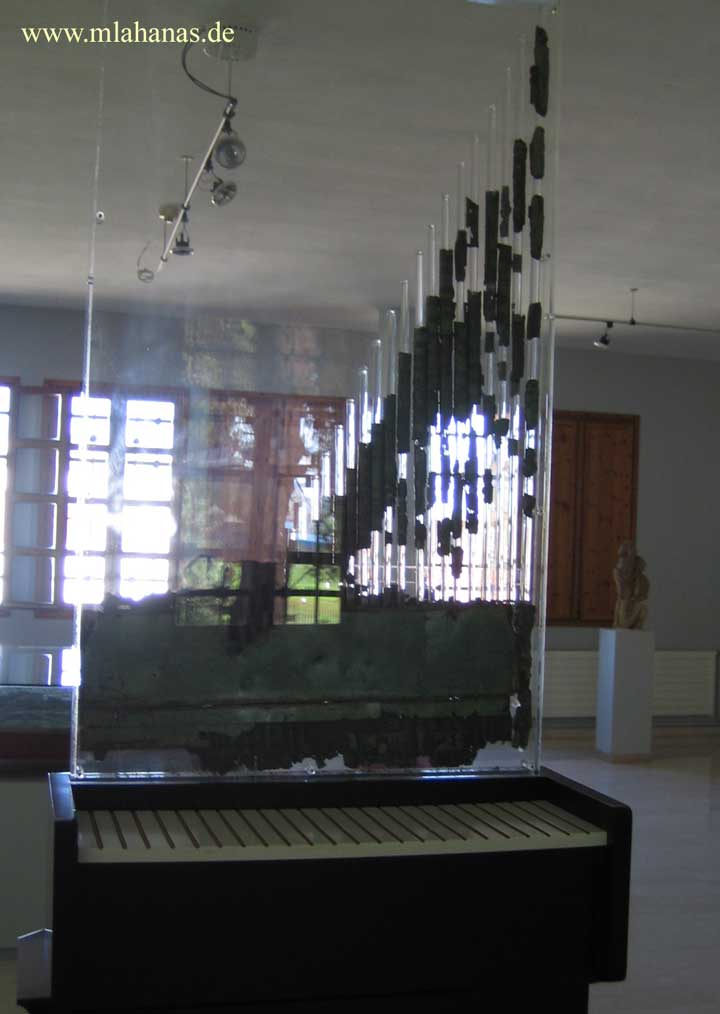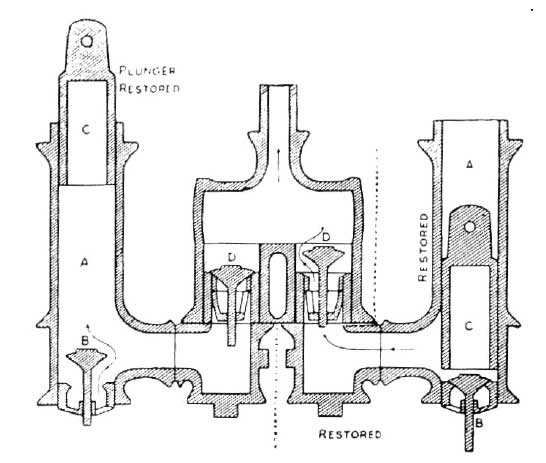
Ctesibius of Alexandria

Ctesibius or Ktesibios or Tesibius (Greek: Κτησίβιος; fl. 285–222 BC) was a Greek inventor and mathematician in Alexandria, Ptolemaic Egypt. He wrote the first treatises on the science of compressed air and its uses in pumps (and even a cannon). This, in combination with his work on the elasticity of air On pneumatics, earned him the title of "father of pneumatics." None of his written work has survived, including his Memorabilia, a compilation of his research that was cited by Athenaeus.
Ctesibius Alexandrinus was the first who found out the properties of the wind, and of pneumatic power, the origin of which inventions is worthy of being known. Ctesibius, whose father was a barber, was born at Alexandria. Endowed with extraordinary talent and industry, he acquired great reputation by his taste for his mechanical contrivances. Marcus Vitruvius Pollio, de Architectura
Ctesibius or Ktesibios of Alexandria, Egypt, was a Greek physicist and inventor around (285 – 222) BC. His lost work On pneumatics still earns him the title of father of pneumatics, for the first treatises on the science of compressed air and its uses in pumps and even a cannon, are his. Like all his other works, however, this work has not survived. His Memorabilia, a compilation of his research, cited by Athenaeus, is also lost.
Ctesibius was probably the first head of the Museum of Alexandria. Unfortunately, very little is known of his life and work. His work is chronicled in Vitruvius, Athenaeus, Philo of Byzantium who repeatedly mentions him, adding, with an almost audible sigh, that the first mechanicians had the advantage of being under kings who loved fame and supported the arts. Proclus, the commentator on Euclid and Hero of Byzantium the last of the engineers of antiquity also mention his, though nothing of his has survived.
Ctesibius was the son of a barber from Aspondia in Alexandria. He also started his life as a barber and his first invention was a counter-weighted mirror. The mirror was on one end of a pole and a lead weight, weighing the same as the mirror, was on the other. This acted as a counterbalance and enabled the mirror to adjust to the height of different customers. Ctesibius had the lead counter-balance weight running inside a tube and noticed that the weight sometimes made a whistling noise as the air escaped when the weight moved. This effect provoked his curiosity about both the powers of air, and musical instruments. When he was small, he dropped a lead ball in a tube and the air escaped with a loud sound because the ball compressed the air. Because of this finding, Ctesibius realized that air was also a substance, so his inventions were based on this fact.
Ctesibius is known for his improvement of the waterclock. This invention is similar to the mechanism used in the 20th-century flush toilet. The floating valve is the predecessor of the floating ball in the upper chamber of the toilet. After a flush, the floating ball sinks with the declining water level, pulling open the water valve with its metal arm. The incoming water fills the vessel again, raising the ball so that its arm closes the flow of water at the precise level of "full..

Mankind was a long time in developing adequate measures for fighting fire. The early Greeks and Romans used a device called the Ctesibius pump to create a stream of water. The idea was lost, ironically, in the burning of Alexandria, Ctesibius home city. This technology was forgotten, however, during the Middle Ages. By the time the colonists arrived in America, townfolk still depended on the bucket brigade; two lines of people connecting the water source and the fire, one passing full buckets, the other returning the empties. Wet blankets protected threatened structures. By the eighteenth century the principle behind the Ctesibius pump had been rediscovered and hand-operated fire engines began making their appearance. As better water systems were developed, higher water pressure became possible. Heavy riveted hoses were developed to handle the increase. The improvement in hoses allowed the firemen to take the water directly from the water plug to the source of the fire. A standard fixture of the early volunteer department was the hand-drawn hose cart consisting of a large reel mounted on two wheels.
The hydraulis ( Ύδραυλις )
About B.C. 284 to 246 there lived at Alexandria, under Ptolemy Euergetes, a man named Ctesibius, who followed his father’s trade of barber. Being of a mechanical turn of mind, he observed that the counterweight of a movable mirror, used for the purposes of his trade, produced a musical sound by the force with which it drove the air out of the tube in which it moved. Experimenting with the principle thus noticed, he succeeded in making a machine consisting of a hollow vase inverted, with an opening on the top, to which was attached a trumpet, and, on water being pumped into the vase the air was driven forcibly through the trumpet, producing a very powerful sound; and the machine caused so much admiration that it was consecrated in the temple of Venus. Charles Francis Abdy Williams The Story of the Organ, 1903.
Ctesibius invented a water organ, which was an air pump with valves on the bottom, a tank of water in between them and a row of pipes on top.

The hydraulis was the first keyboard musical instrument and the ancestor of the modern church organ. It utilized a large chamber partly filled with water. Ctesibius evidently took the idea of his organ from the Syrinx or Pandean pipes, a musical instrument of the highest antiquity among the Greeks. His object being to employ a row of pipes of great size, and capable of emitting the most powerful as well as the softest sounds, he contrived the means of adapting keys with levers (agkoniskoi), and with perforated sliders (pomata) to open and shut the mouths of the pipes (glossokoma), a supply of wind being obtained, without intermission, by bellows, in which the pressure of water performed the same part which is fulfilled in the modern organ by a weight.
The instrument was called the water-organ (hydraulis). The wide mouth of a funnel-like extension from the wind chest was set in the top of the water; as air pressure in the wind chest fell, water rose in the funnel and compressed the air, thus keeping the air pressure constant. The hydraulis was used for public entertainments in ancient Rome and Byzantium. Nero the mad Roman Emperor is said to used a hydraulis. Bellows-type organs were also known to the ancient world. This was the organ that reappeared in Europe in the 8th and 9th centuries, imported from Byzantium and from Arabs who had discovered ancient Greek treatises.

(The Hydraulis of Dion)
In 1992 Greek archaeologists recovered a fragmentary hydraulis with 19 bronze tubes dating from the 1st Century B.C. at the Greek city of Dion, at the foot of Mt. Olympus. Based on this example and documentary evidence, the European Cultural Centre of Delphi finished reconstructing the instrument in 1999.
Ctesibius invented a water organ, which was an air pump with valves on the bottom, a tank of water in between them and a row of pipes on top.

...The writings speak of water-blown pipes, which were used to simulate the singing of birds and the sound of a trumpet blown by a statue of Memnon in Thebes. This statue has been called one of the world’s wonders. When the sun shone upon the statue from a certain angle (particular time of day), an awe-inspiring sound was emitted, according to Tacitus, Pausanius and other writers. They compared the sound, produced by two organ pipes, to the sound of the bursting strings of a lyre or harp. The sun's rays fell onto a sealed tank, which was partially filled with water. When the water was heated and had expanded sufficiently, it was forced through a siphon into a second tank. The air, which was displaced from the second tank, blew the two pipes. During the cooler night, a vacuum was created in the first tank causing water to be drawn in from a reservoir thus making the instrument ready for the next day. The tank was shielded from the sun so that the sun’s energy would warm it only at a very specific time of day. In another Greek example, a pipe or whistle was blown to imitate the chirping of a bird. An artificial bird was placed on top of an artificial tree on top of a mechanism similar to the one described above. The warbling of the bird was imitated by the inversion of the sounding pipe into a tank filled with water. This instrument was not solar-powered, and had to be activated by turning on a tap. It could only play until all of the water had flowed from the first tank into the second one. Aristokles (second-century BC) speaks of an instrument he calls the organon referring to a water organ, which made figures play wind, string and percussion instruments. Joseph R. Curtis, The Water Organ and Other Related Sound-Producing Automata
Pump of Ctesibius
By Ctesibius around 250 BC.
It is now necessary to explain the machine of Ctesibius, which raises water to a height. It is made of brass, and at the bottom are two buckets near each other, having pipes annexed in the shape of a fork, which meet at a basin in the middle. In the basin are valves nicely fitted to the apertures of the pipes, which, closing the holes, prevent the return of the liquid which has been forced into the basin by the pressure of the air. Above the basin is a cover like an inverted funnel, fitted and fastened to it with a rivet, that the force of the water may not blow it off. On this a pipe, called a trumpet, is fixed upright. Below the lower orifices of the pipes the buckets are furnished with valves over the holes in their bottoms. Pistons made round and smooth, and well oiled, are now fastened to the buckets, and worked from above with bars and levers, which, by their alternate action, frequently repeated, press the air in the pipes, and the water being prevented from returning by the closing of the valves, is forced and conducted into the basin through the mouths of the pipes; whence the force of the air, which presses it against the cover, drives it upwards through the pipe: thus water on a lower level may be raised to a reservoir, for the supply of fountains.
Another invention of Ctesibius is a cannon that works with compressed air.
[Ctesibius] is also credited with a considerable number of inventions designed for entertainment, the so-called automata. These included a singing cornucopia, incorporated into the funeral monument erected by Ptolemy Philadelphus in honor of his wife and sister Arsinoë; and a cam-operated statue of the mysterious deity that figured prominently in the famous Grand Procession, where it carried out a continuous performance, entertaining the festival crowd by standing up and sitting down. The excitement produced by this very simple application of a rack-and-pinion gear may well be due to the fact that toothed gear wheels were a recent invention, which almost certainly meant that their possibilities were still being explored (there is a passage in the Problemata in which the author finds the reverse motion created by two intersecting cogwheels intriguing) Hellenistic History and Culture. Some Thoughts on the Contribution of Science (Pure and Applied) to the Culture of the Hellenistic Age

(Roman Pump Technology 100 AD)
Click here to read: Vitruvius : the ten books on architecture
[1]
Sources
[1] "MLahanas" by Michael Lahanas
Our Mobile Application
Check out Our Mobile Application "Ancient Greece Reloaded"


